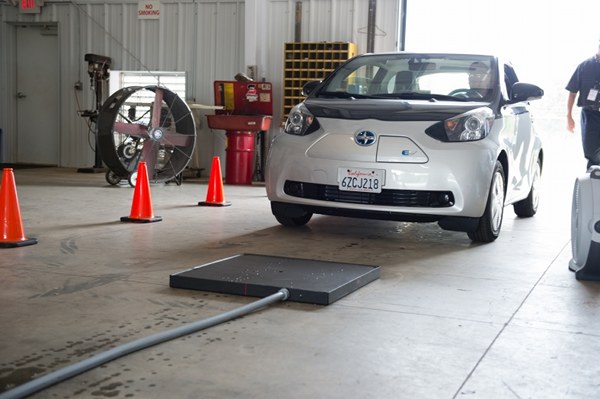
Researchers from Oak Ridge National Laboratory test a wireless charger on the fully-electric Toyota Scion iQ at a demonstration site. (Photo courtesy Oak Ridge National Laboratory)
By Nay Chehab
What if charging your plug-in electric vehicle was as easy as parking it? No need for cords or cards. Just as Wi-Fi has freed consumers of wires when accessing the Internet, wireless charging technology may soon be as widespread, thanks to research supported by the U.S. Department of Energy.
With support from the Vehicle Technologies Office, Oak Ridge National Laboratory and Hyundai America Technical Center Inc. have been working since 2012 to demonstrate wireless charging on a variety of vehicles. ORNL is working with a mix of Toyota vehicles, including models of the all-electric RAV 4, plug-in hybrid electric Prius, and all-electric Scion iQ, while Hyundai America Technical Center Inc. is testing its technology on five all-electric Kia Souls.
The technology behind wireless charging creates a connection between a transmitting pad on the ground (such as in a garage) and a receiving pad integrated on the bottom of the vehicle. In the projects ORNL is leading, the transmitting pad is connected to a 240-volt outlet and generates a magnetic field of a certain frequency. When the coil in the receiving pad is tuned to oscillate at the same frequency, the magnetic field will generate a current in the receiving coil, charging the vehicle’s battery.
Engineers are developing systems under these projects aimed at exceeding the power and speed of wired Level 2 charging. Level 2 charging currently takes about four to six hours to charge most all-electric vehicles. The projects are focusing on high power charging with a transfer of more than 6.6 kilowatts (kW). In the future, the engineers hope to reach 10kW and eventually 19kW to facilitate faster charging.
After initial testing, researchers will send the vehicles and charging units for validation testing at Idaho National Laboratory. ORNL has already sent one of its developed vehicles there for researchers to fully examine, and Hyundai will be doing the same as soon as it finalizes its prototype. This form of testing ensures that the systems meet international safety standards. For example, the transmitted energy cannot interfere with a pacemaker and other medical devices or harm human health. In addition, Idaho National Laboratory researchers will test how well these devices detect objects, so that, for instance, if a pet runs under the vehicle, the system would shut down and alert the owner.
Beyond static charging, ORNL is already looking ahead at the next phase of wireless charging that can be used for low-speed dynamic charging, with vehicles moving up to 25 miles per hour. In the future, drivers may be able to charge their cars while driving! Wireless charging, be it static or dynamic, will bring real benefits to the real world sooner than people expect.
Nay Chehab is a program analyst in the U.S. Department of Energy’s Office of Energy Efficiency and Renewable Energy.
Note: This story was originally published on the website of the DOE Office of Energy Efficiency and Renewable Energy on March 7.
Leave a Reply